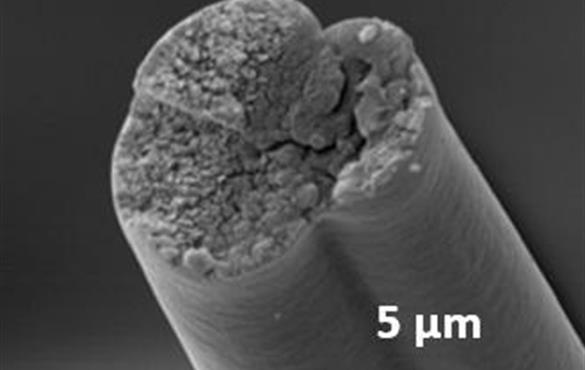In the media: NASA is Funding Research to Create 'Bacteria Factories' for Space Missions of the Future
Energy, Environmental & Chemical Engineer Fuzhong Zhang and his team are helping to develop essential supplies for long-term missions as humanity ventures further into space

As humanity ventures further and further into space, there will be an increasing demand for highly efficient technologies that can recycle onboard resources in order to produce essential supplies for long-term missions.
Now, a team of scientists has described a new technique that could potentially fulfil such a function, according to NASA-funded research presented today at the American Chemical Society's Spring 2019 National Meeting & Exposition.
Thanks to recent developments in the field of synthetic biology, the team, led by Fuzhong Zhang from Washington University in St. Louis, has found a way to engineer bacteria so that they can produce spider silk and other hard-to-manufacture proteins which could be useful in future space missions.
Spider silk is one of several protein-based substances that have evolved in nature, whose properties rival—and often surpass—even the most advanced man-made materials. Spider silk, for example, is pound for pound, stronger and tougher than steel. However, unlike steel, it cannot be produced on large scales, limiting its usefulness to humans.
"In nature, there are a lot of protein-based materials that have amazing mechanical properties, but the supply of these materials is very often limited," Zhang said in a statement. "My lab is interested in engineering microbes so that we can not only produce these materials, but make them even better."
If we were able to produce the material on a large-scale, it could be used in everything from surgical sutures to bullet-proof fabric. The problem is that individual spiders do no produce large quantities of it and keeping significant numbers of the animal together often results in cannibalism.
To get around this problem, various research groups have previously tried to add spider DNA to different surrogate organisms—such as bacteria, yeast and even goats—so that they can produce the silk themselves. But to date, the resulting material has never quite been a match for real spider-silk.
This is because the DNA responsible for producing spider-silk proteins is very unstable when placed into another organism due to the sequences being very long and repetitive. So Zhang and his team tried breaking up the long and repetitive DNA sequences into small chunks that could be inserted into bacteria. These bacteria were then able to produce small amounts of spider-silk protein that could then be spun into longer fibers using a special technique.
The material that the team created was very similar to natural spider-silk and displayed incredible strength, toughness and stretchability. Furthermore, they were able to produce as much as 2 grams of silk per liter of bacteria—a significant amount—and they hope to increase yields further.
The synthetic spider-silk could be particularly useful on future long-term space missions, according to Zhang. "NASA is one of our funders, and they are interested in bio-production," he said.
Furthermore, the technique that the researchers developed can also be used to produce other protein-based materials which could be useful here on Earth. For example, they created a protein from mussels that sticks strongly to surfaces, even when underwater.
Now, a team of scientists has described a new technique that could potentially fulfil such a function, according to NASA-funded research presented today at the American Chemical Society's Spring 2019 National Meeting & Exposition.
Thanks to recent developments in the field of synthetic biology, the team, led by Fuzhong Zhang from Washington University in St. Louis, has found a way to engineer bacteria so that they can produce spider silk and other hard-to-manufacture proteins which could be useful in future space missions.
Spider silk is one of several protein-based substances that have evolved in nature, whose properties rival—and often surpass—even the most advanced man-made materials. Spider silk, for example, is pound for pound, stronger and tougher than steel. However, unlike steel, it cannot be produced on large scales, limiting its usefulness to humans.
"In nature, there are a lot of protein-based materials that have amazing mechanical properties, but the supply of these materials is very often limited," Zhang said in a statement. "My lab is interested in engineering microbes so that we can not only produce these materials, but make them even better."
If we were able to produce the material on a large-scale, it could be used in everything from surgical sutures to bullet-proof fabric. The problem is that individual spiders do no produce large quantities of it and keeping significant numbers of the animal together often results in cannibalism.
To get around this problem, various research groups have previously tried to add spider DNA to different surrogate organisms—such as bacteria, yeast and even goats—so that they can produce the silk themselves. But to date, the resulting material has never quite been a match for real spider-silk.
This is because the DNA responsible for producing spider-silk proteins is very unstable when placed into another organism due to the sequences being very long and repetitive. So Zhang and his team tried breaking up the long and repetitive DNA sequences into small chunks that could be inserted into bacteria. These bacteria were then able to produce small amounts of spider-silk protein that could then be spun into longer fibers using a special technique.
The material that the team created was very similar to natural spider-silk and displayed incredible strength, toughness and stretchability. Furthermore, they were able to produce as much as 2 grams of silk per liter of bacteria—a significant amount—and they hope to increase yields further.
The synthetic spider-silk could be particularly useful on future long-term space missions, according to Zhang. "NASA is one of our funders, and they are interested in bio-production," he said.
"They're currently developing technologies in which they can convert carbon dioxide into carbohydrates that could be used as food for the microbes that we're engineering. That way, astronauts could produce these protein-based materials in space without bringing a large amount of feedstocks."
Furthermore, the technique that the researchers developed can also be used to produce other protein-based materials which could be useful here on Earth. For example, they created a protein from mussels that sticks strongly to surfaces, even when underwater.




